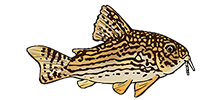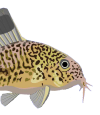Hernández, CL, A Ortega-Lara, GC Sánchez-Garcés & MH Alford, 2015. Genetic and morphometric evidence for the recognition of several recently synonymized species of trans-Andean Rhamdia (Pisces: Siluriformes: Heptapteridae). Copeia 2015: 563–579.
Abstract
A recent taxonomic revision of the Neotropical catfish genus Rhamdia (Pisces: Siluriformes: Heptapteridae) reduced a number of described species to synonymy, especially under a broadly circumscribed R. quelen. Evidence is presented here from DNA sequence data, external morphology, and morphometrics that argues for the recognition of R. guatemalensis in Central and northern South America and R. saijaensis and R. cinerascens in the Pacific drainages of Colombia and Ecuador, respectively. The DNA data indicate that all trans-Andean samples form a monophyletic group, within which there are separate clades corresponding to R. laticauda and the synonymized R. guatemalensis, R. saijaensis, and R. cinerascens. The morphometric data substantiate the phylogenetic groupings, and in external morphology, each putative species has diagnostic characters. Rhamdia guatemalensis is characterized by insertion of the adipose fin closer to the dorsal fin than to the caudal fin and presence of a conspicuous lateral longitudinal dark band; R. saijaensis is characterized by a small head with head length 20.8–23.4% of standard length and by lacking a lateral longitudinal band; and R. cinerascens is characterized by a large head with head length 25.8–30.1% of standard length, base of the adipose fin 30.3–33.3% of standard length, outer mental barbels extending to the base of the pectoral rays, and presence of a faint lateral longitudinal band. The external morphological differences and phylogenetic relationships indicate that these groups are both recognizable and represent independent lineages, which argue for their recognition as species.
Trans-Andean Rhamdia
- Silurus
- Posts: 12461
- Joined: 31 Dec 2002, 11:35
- I've donated: $12.00!
- My articles: 55
- My images: 896
- My catfish: 1
- My cats species list: 90 (i:1, k:0)
- Spotted: 428
- Location 1: Singapore
- Location 2: Moderator Emeritus
- Shovelnose
- Posts: 1254
- Joined: 03 Sep 2008, 09:49
- My articles: 5
- My images: 116
- My catfish: 4
- My cats species list: 60 (i:4, k:0)
- Spotted: 44
- Location 1: Mumbai
- Location 2: India
Re: Trans-Andean Rhamdia
A copy if possible HH.
Thanks,
Thanks,
Balaji
Major: Now what's this... stone, stone, stone, (looks down at his hand) and scissors. Now. Scissors cut everything, don't they?
Sergeant: Not stone, sir.
Major: They're very good scissors!!
Major: Now what's this... stone, stone, stone, (looks down at his hand) and scissors. Now. Scissors cut everything, don't they?
Sergeant: Not stone, sir.
Major: They're very good scissors!!
- bekateen
- Posts: 9650
- Joined: 09 Sep 2014, 17:50
- I've donated: $40.00!
- My articles: 4
- My images: 143
- My cats species list: 146 (i:106, k:34)
- My aquaria list: 37 (i:14)
- My BLogs: 44 (i:154, p:2563)
- My Wishlist: 36
- Spotted: 184
- Location 1: USA, California, Stockton
- Location 2: USA, California, Stockton
- Contact:
Re: Trans-Andean Rhamdia
Here's the Ph.D. dissertation that preceded the above paper. Perhaps you'll find more info in the dissertation:
http://search.proquest.com/pqdtglobal/d ... ntid=14704
http://search.proquest.com/pqdtglobal/d ... ntid=14704
Find me on YouTube & Facebook: http://youtube.com/user/Bekateen1; https://www.facebook.com/Bekateen
Buying caves from https://plecocaves.com? Plecocaves sponsor Bekateen's Fishroom. Use coupon code bekateen for 15% off your order. Also, for you Swifties: Https://youtu.be/ZUKdhXL3NCw





